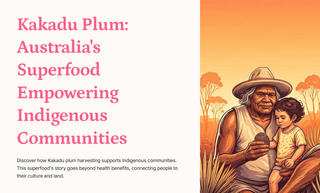As a naturopath at D2E Naturopathy, I'm not just excited about the incredible health benefits of Kakadu plum – I'm thrilled to share the remarkable story behind its harvest.
Key Takeaways Table
| Fact | Details |
|---|---|
| ✅ Primary Harvesters | Indigenous Australians |
| ✅ Harvesting Season | Late dry season to early wet season |
| ✅ Economic Impact | Provides income for remote communities |
| ✅ Cultural Significance | Preserves traditional knowledge |
| ✅ Sustainability | Uses traditional, eco-friendly methods |

The Kakadu Plum Superfood with a Super Story
This isn't just about a superfood; it's about super people and their connection to Country. Let's look into how Kakadu plum harvesting is supporting Indigenous communities and why your purchase makes a real difference.

The Ancient Roots of Kakadu Plum Harvesting
Before we get into the nitty-gritty, let's take a step back in time:
- ✅ Traditional Use: Indigenous Australians have been using Kakadu plum for thousands of years
- ✅ Bush Tucker: A vital food source in traditional diets
- ✅ Medicinal Properties: Used in traditional medicine for various ailments
- ✅ Spiritual Significance: Connected to Dreamtime stories and cultural practices
Indigenous-led Kakadu Plum Harvesting: A Sustainable Approach
1. Traditional Ecological Knowledge in Action
Indigenous harvesters bring centuries of wisdom to the table:
- 🍃 Understanding of natural cycles and seasons
- 🌿 Selective harvesting to ensure tree health
- 🐾 Minimal impact on surrounding ecosystems
2. Preservation of Biodiversity
Harvesting practices that protect more than just the plums:
- 🦘 Maintaining habitats for native wildlife
- 🌺 Encouraging growth of other native plants
- 🌍 Contributing to overall ecosystem health
3. Sustainable Harvesting Techniques
Methods that have stood the test of time:
- ✅ Hand-picking to avoid damage to trees
- ✅ Harvesting only ripe fruit
- ✅ Leaving enough fruit for natural regeneration

How Kakadu Plum Harvesting Supports Remote Aboriginal Communities
1. Economic Empowerment
Harvesting brings vital income to remote areas:
- Fair trade practices ensure equitable compensation
- Creation of Indigenous-owned businesses
- Opportunities for economic growth and independence
2. Cultural Preservation
More than just a job – it's a connection to culture:
- Passing down traditional knowledge to younger generations
- Strengthening community bonds through shared activities
- Inspiring cultural pride and identity
3. Health and Wellbeing
Benefits that go beyond the financial:
- Encouraging consumption of nutritious traditional foods
- Promoting physical activity through harvesting
- Supporting mental health through connection to country
4. Education and Skills Development
Building capacity within communities:
- Training in business management and marketing
- Opportunities to engage with scientific research
- Development of digital skills for e-commerce
Premium KAKADU PLUM Powder Wild Australian Superfood
This native Australian fruit boasts the highest recorded levels of Vitamin C, containing over 100 times the amount found in oranges!
View NowGUT OPTIMAX Health Superfood Powder 65g - Slippery Elm, Aloe Vera.
Gut Optimax is a powerful, food-based prebiotic blend formulated by our naturopath to help you achieve optimal gut health.
View NowThe Ripple Effect: Broader Impacts of Sustainable Kakadu Plum Harvesting
-
Environmental Conservation:
- Incentive to protect native Kakadu plum habitats
- Traditional fire management practices reducing bushfire risks
-
Cultural Exchange:
- Fostering understanding between Indigenous and non-Indigenous Australians
- Sharing Indigenous knowledge with the global community
-
Research Opportunities:
- Collaborations between Indigenous knowledge holders and scientists
- Potential discoveries of new medicinal properties
-
Sustainable Development Model:
- Providing a blueprint for other Indigenous-led enterprises
- Contributing to global sustainable development goals

Q&A: Your Questions About Sustainable Kakadu Plum Harvesting Answered
Q: Is wild harvesting of Kakadu plum sustainable?
A: Yes, when done using traditional Indigenous methods that respect natural cycles and ecosystem balance.
Q: How can I ensure the Kakadu plum products I buy support Indigenous communities?
A: Look for products that are certified by Indigenous-owned cooperatives or have clear fair trade practices.
Q: Does harvesting Kakadu plum harm the environment?
A: Traditional harvesting methods actually contribute to environmental health by maintaining biodiversity and natural habitats.
Q: Can non-Indigenous people participate in Kakadu plum harvesting?
A: While harvesting is primarily done by Indigenous communities, there are sometimes opportunities for respectful cultural exchange and learning.
Sustainability and Community Impact
Kakadu plum harvesting supports Indigenous Australian communities.
Promotes sustainable land management practices in the Australian Outback.
Creates economic opportunities for Indigenous communities.

How You Can Support Indigenous Kakadu Plum Harvesters
- ✅ Buy Authentic: Choose Kakadu plum products from Indigenous-owned businesses
- ✅ Spread the Word: Share the story behind Kakadu plum with friends and family
- ✅ Learn More: Educate yourself about Indigenous Australian culture and history
- ✅ Support Initiatives: Look for programs that promote Indigenous land management
- ✅ Visit Respectfully: If traveling to Kakadu, choose Indigenous-led tours and experiences

A Superfood with Super Impact
Kakadu plum isn't just a nutritional powerhouse – it's a powerful tool for social and environmental change. By supporting sustainable, Indigenous-led harvesting practices, we're not just getting a healthy boost; we're contributing to the wellbeing of communities, the preservation of ancient cultures, and the health of our planet.
As a naturopath, I'm always excited about foods that nourish our bodies. But as a member of the global community, I'm even more thrilled about practices that nourish our world. Kakadu plum harvesting does both, making it a true superfood in every sense of the word.
So next time you sprinkle some Kakadu plum powder into your smoothie or apply a Kakadu plum-infused face cream, remember – you're not just taking care of yourself.
You're part of a bigger story, one of cultural respect, environmental stewardship, and community empowerment. Now that's something we can all feel good about!
About the Author: Frances Simmons. As a qualified naturopath at D2E Naturopathy, I'm passionate about the intersection of health, sustainability, and social justice. My expertise in nutritional medicine, combined with a deep respect for Indigenous knowledge, drives my commitment to promoting superfoods like Kakadu plum that benefit both people and planet.










